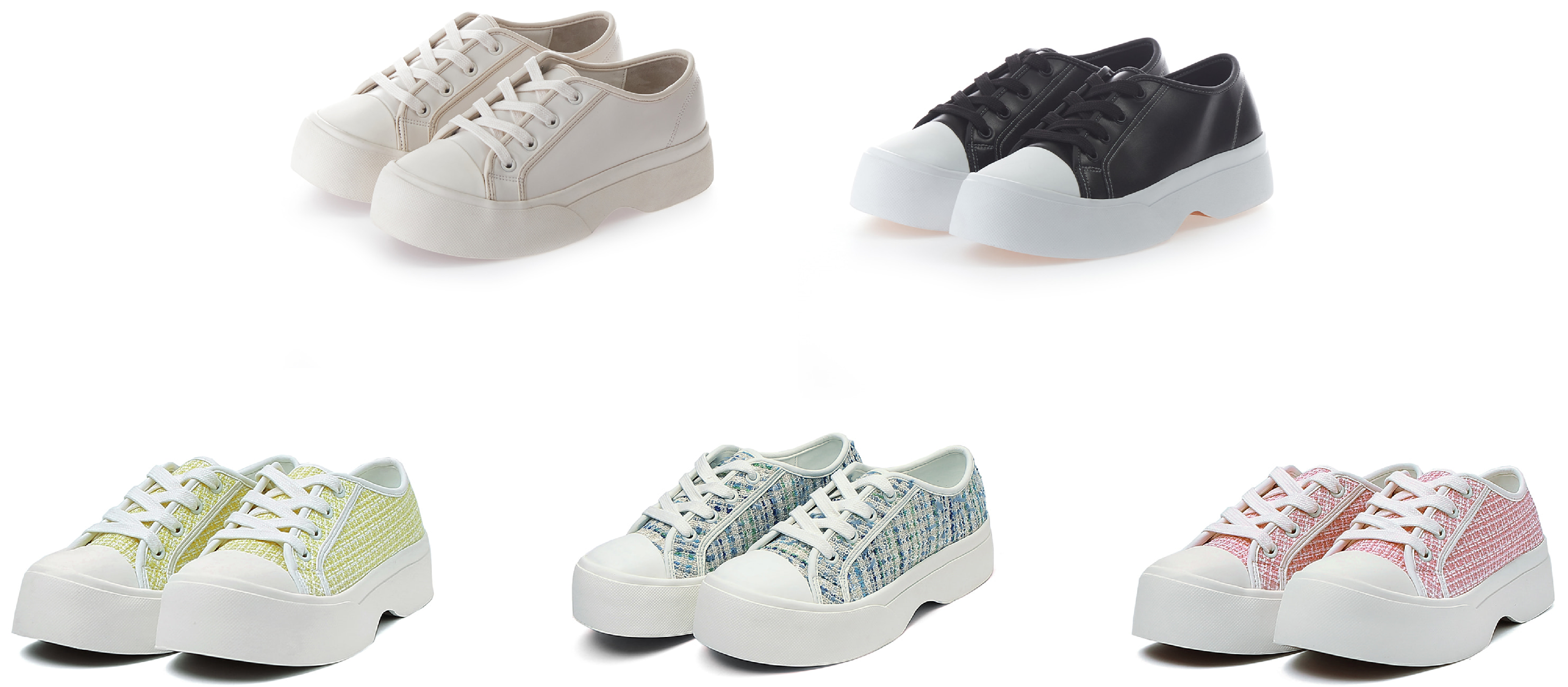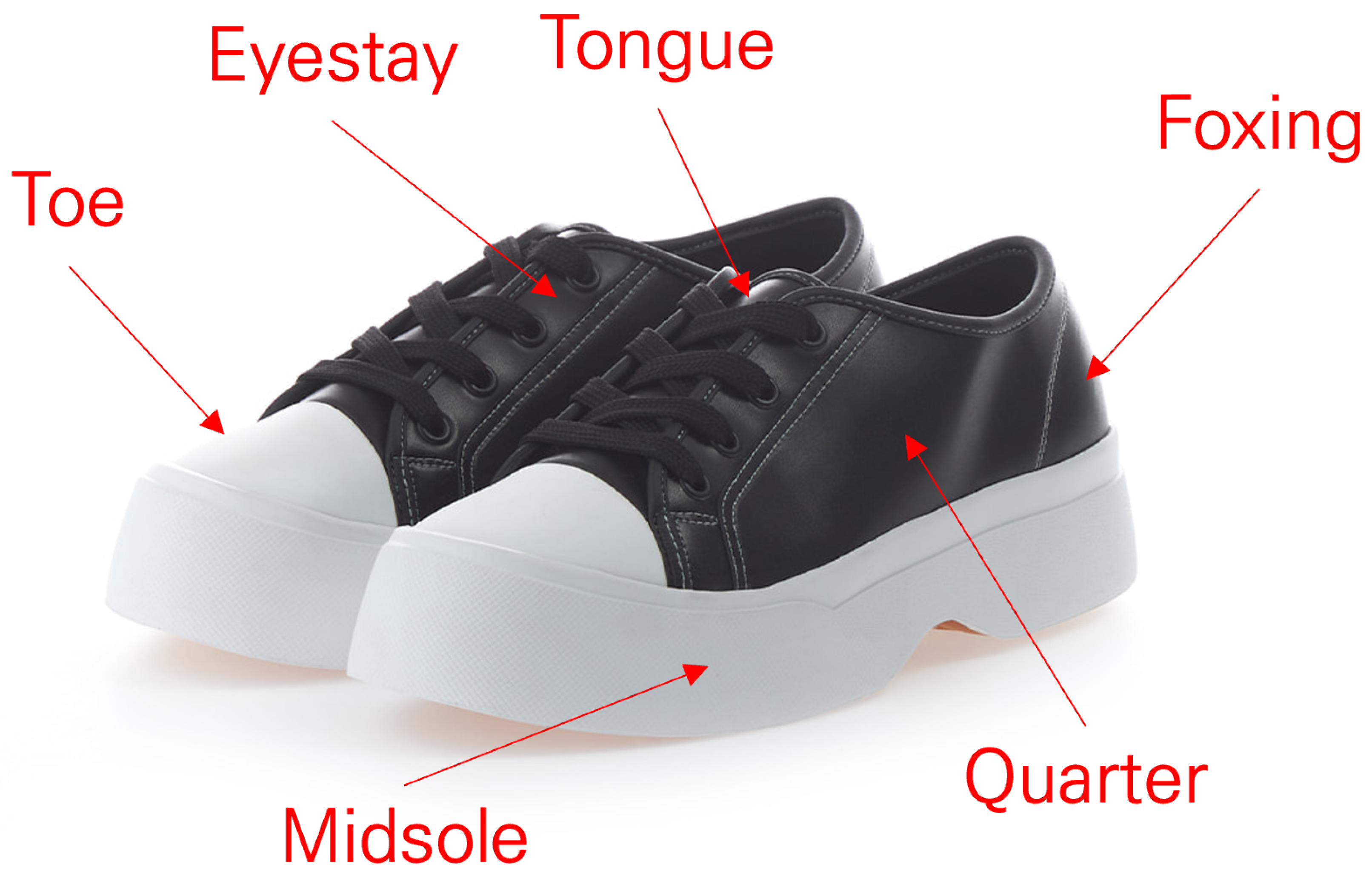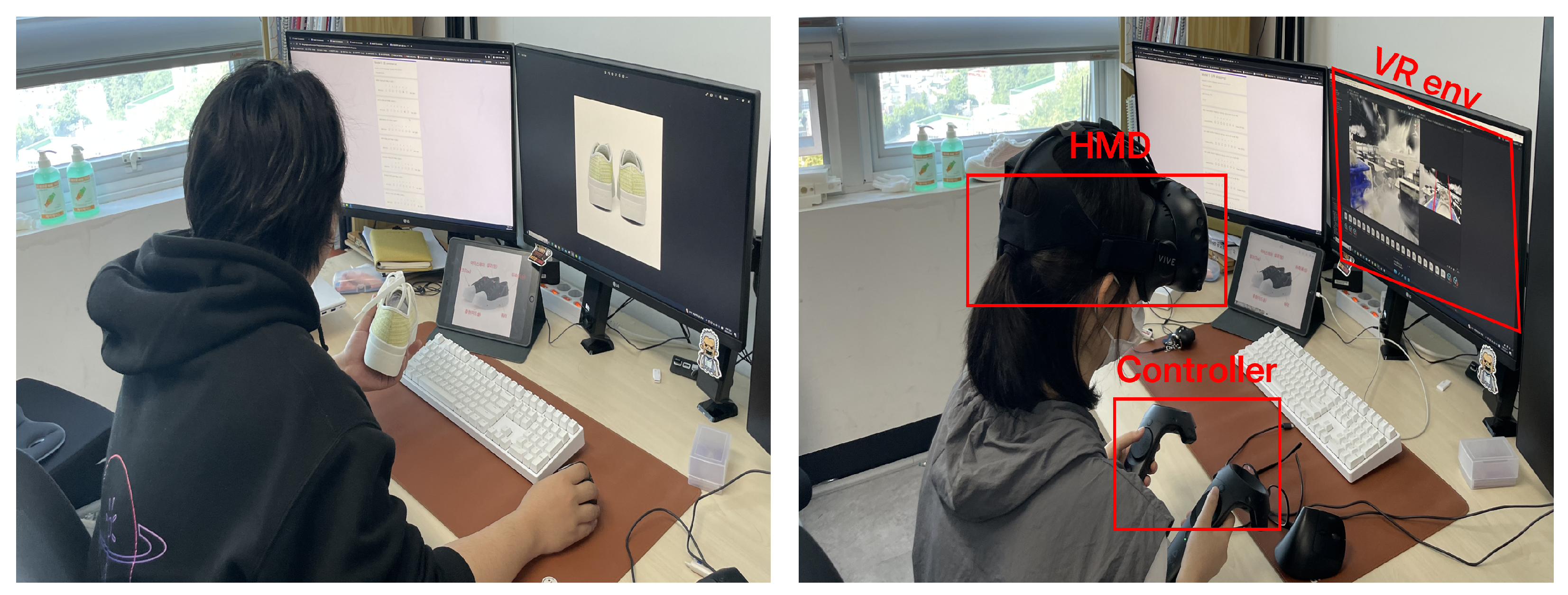Comparative Analysis of Product Information Provision Methods: Traditional E-Commerce vs. 3D VR Shopping
Abstract
1. Introduction
2. Related Works
2.1. Virtual Reality (VR) Shopping
2.2. Kansei Engineering for Shoes
2.3. 3D Visualization Technology
3. Methods
3.1. Selection of Experimental Shoe
3.2. Implementation of Product Information Provision Methods
3.2.1. Product Information Provision Methods of Existing Online Shopping Platforms
3.2.2. Product Information Provision Methods of VR Shopping
3.3. Evaluation Index
3.3.1. Product Emotion Evaluation Metrics
3.3.2. Ease of Product Recognition: Metrics
4. Experiment
4.1. Measurement
4.2. Participants
4.3. Methods
4.4. Procedure
5. Results
5.1. Descriptive Analysis of Participants’ Characteristics
5.2. Results of the Product Emotion Evaluation Questionnaire
5.3. Results of the Product Information Recognition Ease Questionnaire
5.4. Qualitative Survey Results
6. Discussion
6.1. Traditional E-Commerce vs. VR Shopping
6.2. Limitation and Future Works
7. Conclusions
Author Contributions
Funding
Institutional Review Board Statement
Informed Consent Statement
Data Availability Statement
Conflicts of Interest
References
- Kim, Y.; Kim, J. Luxury fashion brands case analysis of using metaverse. J. Fash. Bus. 2022, 26, 50–71. [Google Scholar]
- Speicher, M.; Cucerca, S.; Krüger, A. VRShop: A mobile interactive virtual reality shopping environment combining the benefits of on-and offline shopping. Proc. ACM Interact. Mob. Wearable Ubiquitous Technol. 2017, 1, 102. [Google Scholar] [CrossRef]
- Speicher, M. Shopping in virtual reality. In Proceedings of the 2018 IEEE Conference on Virtual Reality and 3D User Interfaces (VR), Tuebingen/Reutlingen, Germany, 18–22 March 2018; IEEE: Piscataway, NJ, USA, 2018; pp. 1–2. [Google Scholar]
- Zheng, L.; Pan, Y.H. Integrated Shopping Experience on User Centered View: Focusing on the Shopping Phase of Exploration and Comparison. J. Digit. Contents Soc. 2019, 20, 2193–2202. [Google Scholar] [CrossRef]
- Jang, J.Y.; Chun, J. A research on the characteristics of virtual reality stores-Focused on Hyundai VR store and eBay VR department store. J. Korean Soc. Cloth. Text. 2018, 42, 671–688. [Google Scholar] [CrossRef]
- Lee, W.Y. A study of the technical tendency augmented reality and the application of fashion industry. J. Korean Soc. Des. Cult. 2010, 16, 367–377. [Google Scholar]
- Rahman, O. Online consumer choice: Footwear design and visual presentation. J. Text. Appar. Technol. Manag. 2018, 10, 1–19. [Google Scholar]
- Rahmawati, C.H.T.; Tanuwijaya, T.C.; Yuniarto, A.Y. The Influence of Product Design, Sales Promotion and Product Quality on Customer Purchase Decision at Converse Shoes (Study on Millenial Generation). Manaj. Dewantara 2022, 6, 211–224. [Google Scholar] [CrossRef]
- CHENG, S.H.; LEE, C.J. Gender Differences in Footwear Visual Perception. Int. J. Affect. Eng. 2021, 20, 257–264. [Google Scholar] [CrossRef]
- Jatmiko, H.A.; Nugroho, D.S. Implementing Kansei Engineering and Quality Function Deployment Method in Designing Shoes: Case Study at Rejowinangun Original Leather. Log. J. Ranc. Bangun Dan Teknol. 2022, 22, 70–80. [Google Scholar] [CrossRef]
- Tumewu, T.W.; Dharma, I. The Exterior Form Design of Men Formal Shoe with Kansei Engineering Through Structure of Meaning. In Proceedings of the Joint International Conference-APCHI-Ergofuture-PEI-IAIFI 2014, Bali, Indonesia, 22–25 October 2014; Udayana University Press: Bali, Indonesia, 2014. [Google Scholar]
- Shieh, M.D.; Yeh, Y.E. A comparative study on perceptual evaluations of sports shoe exterior colors in Taiwan. Color Res. Appl. 2015, 40, 178–193. [Google Scholar] [CrossRef]
- Chen, Y.C.; Lee, Y.H.; Wu, H.C.; Sung, Y.C.; Chen, H.Y. Online apparel shopping behavior: Effects of consumer information search on purchase decision making in the digital age. In Proceedings of the 2017 IEEE 8th International Conference on Awareness Science and Technology (iCAST), Taichung, Taiwan, 8–10 November 2017; IEEE: Piscataway, NJ, USA, 2017; pp. 143–148. [Google Scholar]
- Bressoud, E. Testing FMCG innovations: Experimental real store versus virtual. J. Prod. Brand Manag. 2013, 22, 286–292. [Google Scholar] [CrossRef]
- Hsu, W.C.; Chen, P.H.; Chen, C.Y. An exploration of the impact of virtual reality interfaces on online shopping. Inf. Resour. Manag. J. (IRMJ) 2020, 33, 19–39. [Google Scholar] [CrossRef]
- Carlson, P.; Kirpes, C.; Pavlik, R.A.; Vance, J.M.; Yin, L.; Scott-Cooper, T.; Lambert, T. Comparison of single-wall versus multi-wall immersive environments to support a virtual shopping experience. In Proceedings of the World Conference on Innovative Virtual Reality, Milan, Italy, 27–29 June 2011; Volume 44328, pp. 287–291. [Google Scholar]
- Dzardanova, E.; Kasapakis, V.; Gavalas, D. Affective impact of social presence in immersive 3D virtual worlds. In Proceedings of the 2017 IEEE Symposium on Computers and Communications (ISCC), Heraklion, Greece, 3–6 July 2017; IEEE: Piscataway, NJ, USA, 2017; pp. 6–11. [Google Scholar]
- Schütte, S.T.; Eklund, J.; Axelsson, J.R.; Nagamachi, M. Concepts, methods and tools in Kansei engineering. Theor. Issues Ergon. Sci. 2004, 5, 214–231. [Google Scholar] [CrossRef]
- Shokri, P. Aesthetic in Designing Shoes; a Necessity to Meet the Needs of Customers. Asian Soc. Sci. 2016, 12, 246. [Google Scholar] [CrossRef][Green Version]
- Kaledio, E.; Oloyede, J.; Lucas, D. Applications and Advancements in 3D Visualization Technology. researchgate.net. 2024. Available online: https://www.researchgate.net/profile/Kaledio-Potter/publication/377700559_Applications_and_Advancements_in_3D_Visualization_Technology/links/65b339ac34bbff5ba7c4cb9e/Applications-and-Advancements-in-3D-Visualization-Technology.pdf (accessed on 4 October 2024).
- Gortler, S.J.; Grzeszczuk, R.; Szeliski, R.; Cohen, M.F. The Lumigraph. In Seminal Graphics Papers: Pushing the Boundaries, Volume 2, 1st ed.; Association for Computing Machinery: New York, NY, USA, 2023. [Google Scholar]
- Levoy, M.; Hanrahan, P. Light field rendering. In Seminal Graphics Papers: Pushing the Boundaries, Volume 2; Association for Computing Machinery: New York, NY, USA, 2023; pp. 441–452. [Google Scholar]
- Buehler, C.; Bosse, M.; McMillan, L.; Gortler, S.; Cohen, M. Unstructured lumigraph rendering. In Proceedings of the 28th Annual Conference on Computer Graphics and Interactive Techniques, Los Angeles, CA, USA, 12–17 August 2001; pp. 425–432. [Google Scholar]
- Snavely, N.; Seitz, S.M.; Szeliski, R. Photo tourism: Exploring photo collections in 3D. ACM Trans. Graph. (TOG) 2006, 25, 835–846. [Google Scholar] [CrossRef]
- Goesele, M.; Snavely, N.; Curless, B.; Hoppe, H.; Seitz, S.M. Multi-view stereo for community photo collections. In Proceedings of the 2007 IEEE 11th International Conference on Computer Vision, Rio de Janeiro, Brazil, 14–21 October 2007; IEEE: Piscataway, NJ, USA, 2007; pp. 1–8. [Google Scholar]
- Mildenhall, B.; Srinivasan, P.P.; Tancik, M.; Barron, J.T.; Ramamoorthi, R.; Ng, R. Nerf: Representing scenes as neural radiance fields for view synthesis. Commun. ACM 2021, 65, 99–106. [Google Scholar] [CrossRef]
- Chen, G.; Wang, W. A survey on 3d gaussian splatting. arXiv 2024, arXiv:2401.03890. [Google Scholar]
- Kerbl, B.; Kopanas, G.; Leimkühler, T.; Drettakis, G. 3D Gaussian Splatting for Real-Time Radiance Field Rendering. ACM Trans. Graph. 2023, 42, 139-1. [Google Scholar] [CrossRef]
- Blijlevens, J.; Creusen, M.E.; Schoormans, J.P. How consumers perceive product appearance: The identification of three product appearance attributes. Int. J. Des. 2009, 3, 27–35. [Google Scholar]







| Luxury | Casual | Mature | Young |
|---|---|---|---|
| Dynamic | Static | Boring | Interesting design |
| Modern | Classic | Safe | Dangerous |
| Simple | Complex | Rounded | Sharp |
| Rough Texture | Fine Texture | Heavy | Lightweight |
| Elegant | Rough | In-Formal design | Formal design |
| Pale | Shiny | Plain Pattern | Camo Pattern |
| Comfortable | Tight |
| Q. | (1) | (7) | Q. | (1) | (7) |
|---|---|---|---|---|---|
| 1 | Luxury | Casual | 9 | Rounded | Sharp |
| 2 | Dynamic | Static | 10 | Heavy | Lightweight |
| 3 | Modern | Classic | 11 | Elegant | Rough |
| 4 | Simple | Complex | 12 | In-Formal design | Formal design |
| 5 | Rough Texture | Fine Texture | 13 | Pale | Shiny |
| 6 | Mature | Young | 14 | Plain Pattern | Camo Pattern |
| 7 | Boring | Interesting design | 15 | Comfortable | Tight |
| 8 | Safe | Dangerous |
| Characteristics | Category | Group | Total | Rate |
|---|---|---|---|---|
| Gender (people) | Male | ALL | 14 | 50% |
| CG | 8 | 57% | ||
| EG | 6 | 43% | ||
| Female | ALL | 14 | 50% | |
| CG | 6 | 43% | ||
| EG | 8 | 57% | ||
| Age Distribution (people) | 20∼25 | ALL | 28 | 100% |
| Average Weekly Usage of Online Shopping Platform (times) | ALL | 6 | ||
| CG | 4.5 | |||
| EG | 7.8 | |||
| Frequency of Purchasing Shoes Online (people) | Yes | ALL | 18 | 64% |
| CG | 10 | 71% | ||
| EG | 8 | 57% | ||
| No | ALL | 10 | 36% | |
| CG | 4 | 29% | ||
| EG | 6 | 43% | ||
| Number of VR Experiences (times) | EG | 1.7 |
Disclaimer/Publisher’s Note: The statements, opinions and data contained in all publications are solely those of the individual author(s) and contributor(s) and not of MDPI and/or the editor(s). MDPI and/or the editor(s) disclaim responsibility for any injury to people or property resulting from any ideas, methods, instructions or products referred to in the content. |
© 2025 by the authors. Licensee MDPI, Basel, Switzerland. This article is an open access article distributed under the terms and conditions of the Creative Commons Attribution (CC BY) license (https://creativecommons.org/licenses/by/4.0/).
Share and Cite
Kim, H.-J.; Jeong, S.C.; Kim, S.-H. Comparative Analysis of Product Information Provision Methods: Traditional E-Commerce vs. 3D VR Shopping. Appl. Sci. 2025, 15, 2089. https://doi.org/10.3390/app15042089
Kim H-J, Jeong SC, Kim S-H. Comparative Analysis of Product Information Provision Methods: Traditional E-Commerce vs. 3D VR Shopping. Applied Sciences. 2025; 15(4):2089. https://doi.org/10.3390/app15042089
Chicago/Turabian StyleKim, Hui-Jun, Seok Chan Jeong, and Sung-Hee Kim. 2025. "Comparative Analysis of Product Information Provision Methods: Traditional E-Commerce vs. 3D VR Shopping" Applied Sciences 15, no. 4: 2089. https://doi.org/10.3390/app15042089
APA StyleKim, H.-J., Jeong, S. C., & Kim, S.-H. (2025). Comparative Analysis of Product Information Provision Methods: Traditional E-Commerce vs. 3D VR Shopping. Applied Sciences, 15(4), 2089. https://doi.org/10.3390/app15042089








